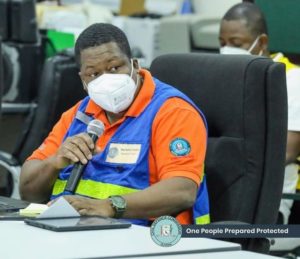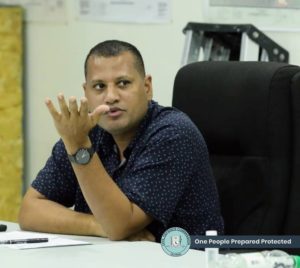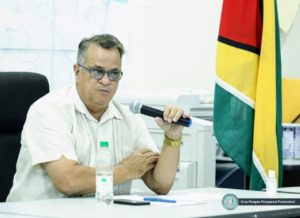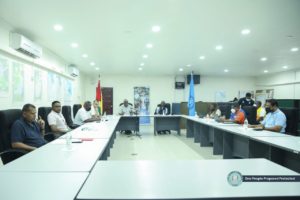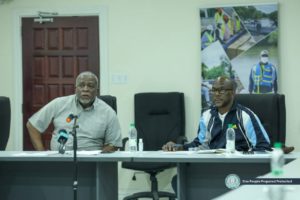- December 13, 2021
- Posted by: Patrice Wishart
- Categories: disaster management, News
No Comments
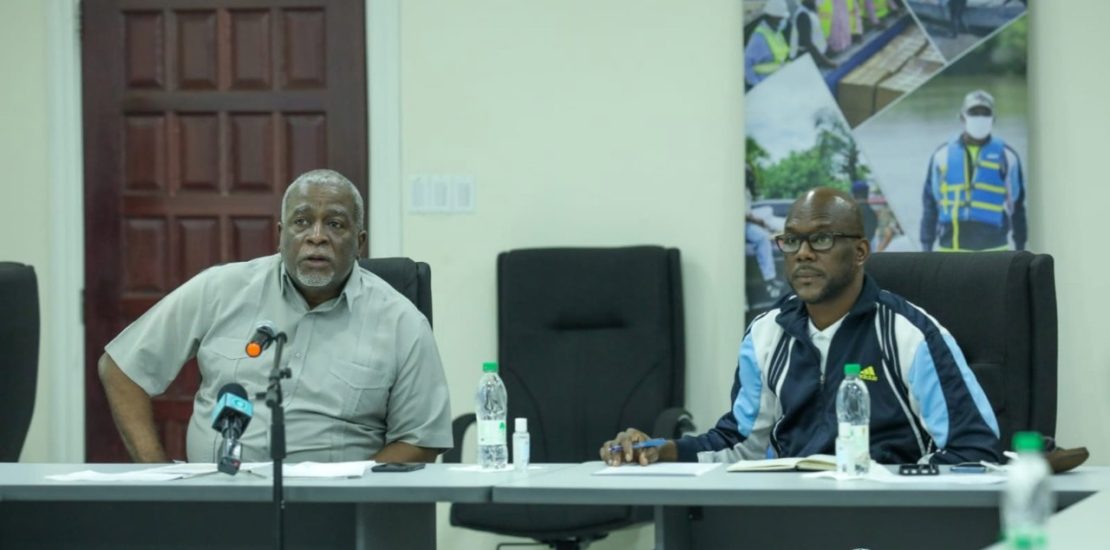
The Honourable Brigadier (Ret’d) Mark Phillips yesterday hosted the first Flood Response Task Force Meeting at the Civil Defence Commission Headquarters. Per the President’s instruction, the Cabinet Level Task Force was activated to proactively address the ongoing rainy season and potential flood response countrywide. The Task Force includes the Prime Minister as Chair and other officials such as the Minister of Agriculture, Minister of Local Government and Regional Development, Minister of Housing and Water, CDC’s Director General, Guyana Defence Force’s (GDF) Chief of Staff, the National Security Advisor, the National Drainage and Irrigation Authority’s (NDIA) Chairman, and the Chief Hydrometeorological Officer.
The objectives of yesterday’s meeting were to apprise stakeholders of the activation of the Cabinet Task Force, to document and consolidate all response actions to date, to determine immediate and medium-term needs, and to maximise the use of resources of all agencies. Prime Minister Phillips opened the session by welcoming those in attendance, both virtually and in CDC’s Operations Room. He indicated the importance of such a Task Force and the need to consistently operate proactively and efficiently.
Dr. Garvin Cummings, Chief Hydrometeorological Officer, updated the Task Force on the weather forecast for the coming days. Dr. Cummings indicated that above normal levels of rainfall are expected across Guyana, especially along the coast. “…we’re looking at at least three to four inches of rainfall across all Regions within the next 24 hours.” The weather specialist indicated that Region 9 can also expect an unseasonably large amount of rainfall over the next few days.
Chairman of the National Drainage and Irrigation Authority, Mr. Lionel Wordsworth, apprised the Task Force on all actions taken thus far by the entity and identified preliminary needs of the NDIA. The Chairman noted that most of the pumps, sluices and kokers are operational and those that are not are being addressed with urgency. The Task Force posited in agreement that parts of Region 2 have been severely impacted and should be closely monitored. Minister Mustapha echoed Mr. Wordsworth’s facts by indicating that pumps have been used to boost water outflow particularly in areas such as Georgetown and Mahaicony. As a result, the water has receded exponentially in these locations.
Major Salim October, Preparedness and Response Manager at CDC, then informed the Task Force on the Commission’s actions to date. CDC has received reports of flooding across 46 communities countrywide, with a total of 5885 households affected. Regions 1 to 6 bear the bulk of the reports, with Regions 1 to 4 experiencing the most impact thus far. Livestock, domestic animals and farmlands are in distress and damages have been conveyed. As of December 12, the CDC has prepositioned response resources in Regions 2, 4 and 9; conducted Rapid Flood Assessments in key affected areas; coordinated support for communities with NDIA, Regional Democratic Councils (RDC) and Neighbourhood Democratic Councils (NDC); distributed sandbags in Lamaha Springs, South Ruimveldt and Section C Sophia; and issued flood, weather and prevention alerts to the public. The Response and Preparedness Manager also indicated that the residents of Guyana must continue to be vigilant, cautious and considerate during this period.
Before the meeting came to a close, the Prime Minister acknowledged vital input from other members such as National Security Advisor Mr. Gerry Gouviea, GDF Chief of Staff, Brigadier Godfrey Bess and Local Government and Regional Development Minister, Mr. Nigel Dharamlall, and Minister of Housing and Water, Mr. Colin Croal, who all vowed to ensure that the collective goals are met and maintained. Each entity assured its readiness to safeguard livelihoods and property and iterated that at this time there is no need for residents to panic. CDC’s Director General, Lieutenant Colonel Kester Craig, stressed the importance of effective communication as an essential tool to combat any hazard or disaster. Persons are encouraged to use all available means of contact to report impacts and weather patterns in their area, with the primary point of contact being their local authorities or the 24-hour National Emergency Monitoring System (NEMS) on 600-7500.

